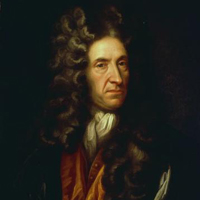Robinson Crusoe by Daniel Defoe: Introduction
Daniel Defoe wrote Robinson Crusoe at the age of fifty-nine and it was an immediate success. The story of Robinson Crusoe that has delighted the young, and the old for that matter, for over two-hundred years was actually based on an experience in the life of a seaman, Alexander Selkirk, who spent four years on the deserted island of Juan Fernandez.

Daniel Defoe
But Selkirk's four years become thirty in Defoe's hands and the story itself is turned into a microcosm of the eighteenth century's triumph over nature. During the thirty years of his stay on the island, Crusoe establishes himself very comfortably, converts his native servant Friday to Christianity, overcomes the savages and is hailed as their master. By the happy device of allowing Crusoe to rescue ammunition and material from his wrecked ship before the storm finally destroys it, Defoe is able to invest every moment of the life on the island with interest. Any withholding of belief was impossible when the reader was confronted with the thousand details of Crusoe's everyday activities-making a sieve, milking goats, preparing his food, and fortifying his home. Nothing was omitted that might delight the new reading public, eager for facts, enchanted by documentary records and demanding the illusion of truth.
The book is a kind of epic of human endeavour ceaselessly striving after some fresh comfort or betterment. Opinions differ as to the sincerity of the religious psychology; there can be no doubt as to the truth of the touches which indicate the desire for companionship. In the hierarchy of Crusoe's retainers, the parrot ranks first, because it can speak words. For sheer power of conveying a set of sensations, all writers agree that nothing can exceed the lonely man's sudden discovery of a footprint on the sand: yet the description of his landing through the surf, his flight before wave after wave, is hardly inferior. And for perfection and beauty of invention, one may cite the incident of corn blades springing up, as it first seemed, by unaccountable providence beside his cave. But like everything else that is recorded as happening to him, this seems so picturesque and yet so credible that we hardly consider the art of the narrator. If verisimilitude in fiction were the highest achievement of an artist, few could rank beside Defoe.
